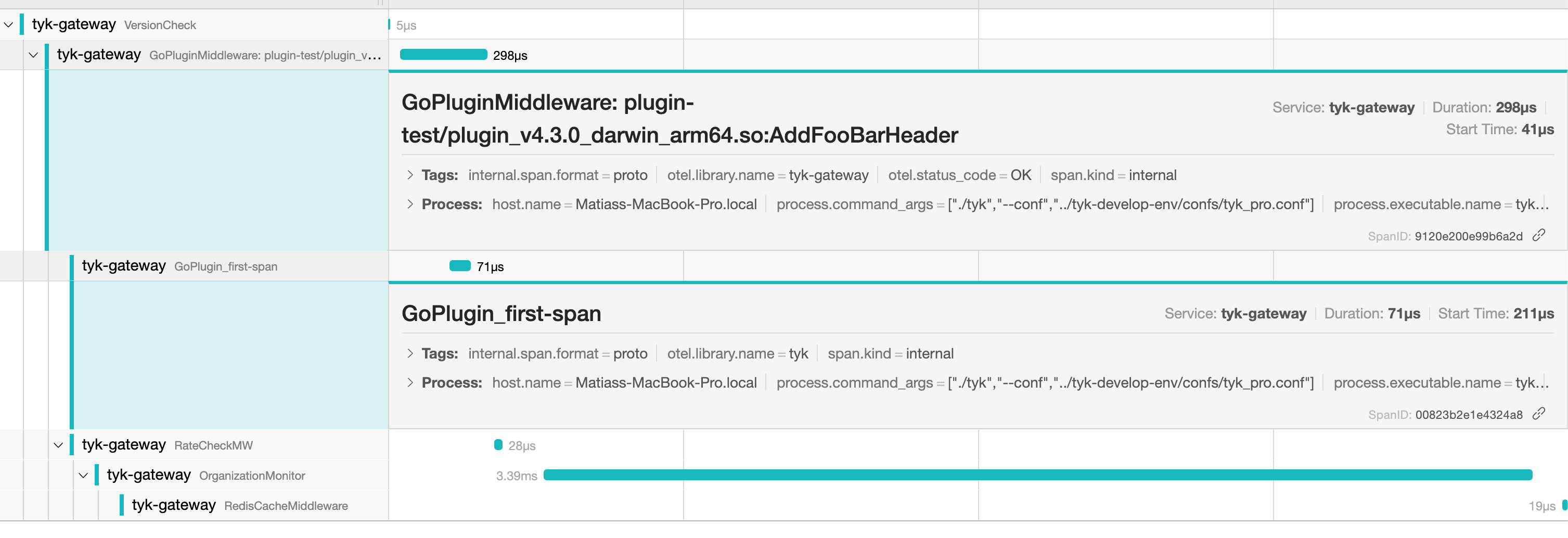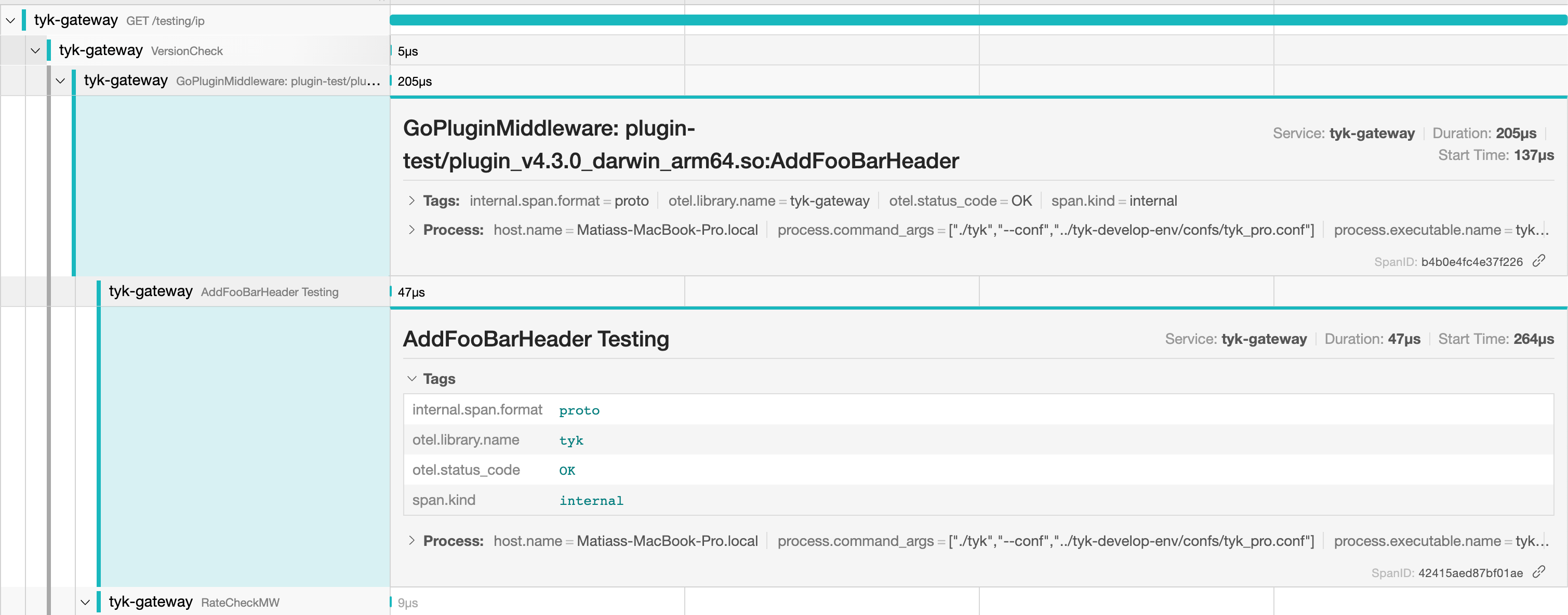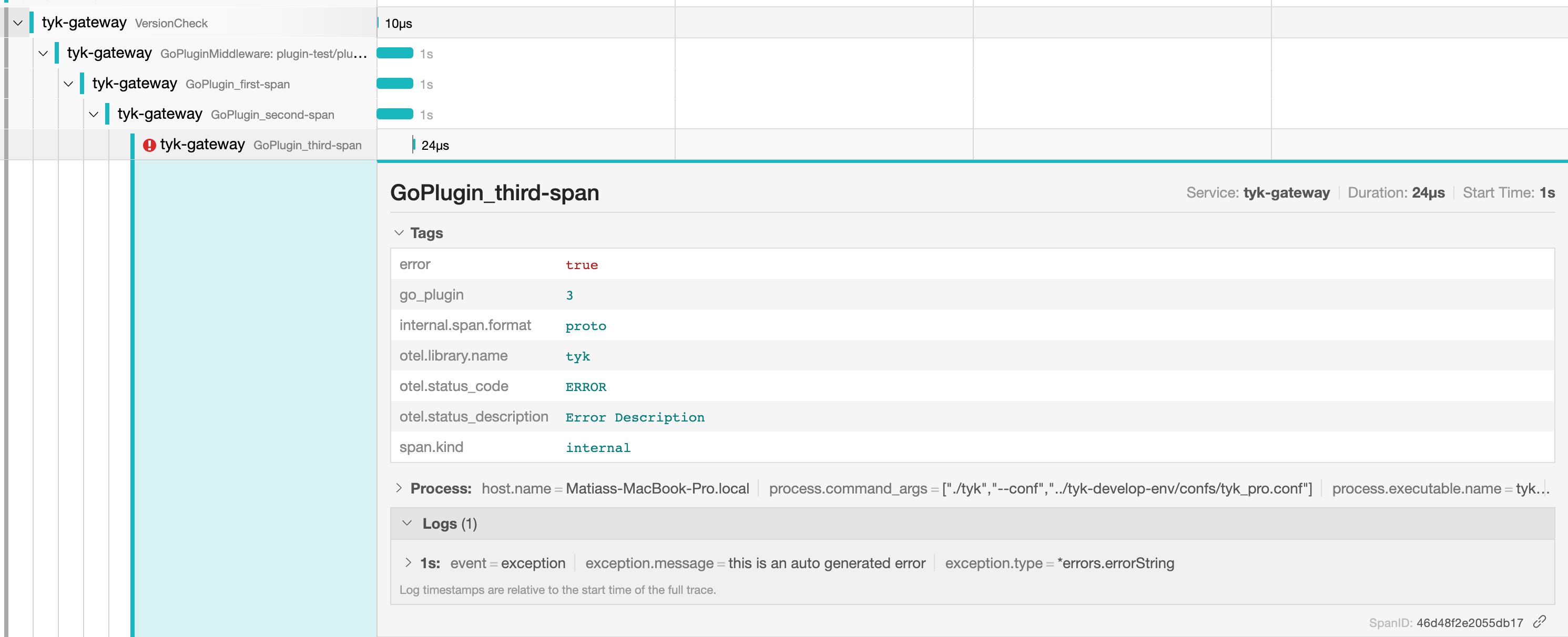CICD - Automating Your Plugin Builds
It’s very important to automate the deployment of your infrastructure.
Ideally, you store your configurations and code in version control, and then through a trigger, have the ability to deploy everything automatically into higher environments.
With custom plugins, this is no different.
To illustrate this, we can look at the GitHub Actions of the example repo.
We see that upon every pull request, a section of steps are taken to “Build, Bundle, Release Go Plugin”.
Let’s break down the workflow file:
Compiling the Plugin
We can see the first few steps replicate our first task, bootstrapping the environment and compiling the plugin into a binary format.
steps:
- uses: actions/checkout@v3
- name: Copy Env Files
run: cp tyk/confs/tyk_analytics.env.example tyk/confs/tyk_analytics.env
- name: Build Go Plugin
run: make go-build
go-build command.
Bundle The Plugin
The next step of the workflow is to “bundle” the plugin.
- name: Bundle Go Plugin
run: docker-compose run --rm --user=1000 --entrypoint "bundle/bundle-entrypoint.sh" tyk-gateway
For added security, please consider signing your bundles, especially if the connection between the Gateways and the Bundler server traverses the internet. Deploy The Plugin
Next step of the workflow is to publish our bundle to a server that’s reachable by the Gateways.
- name: Upload Bundle
uses: actions/upload-artifact@v3
with:
name: customgoplugin.zip
path: tyk/bundle/bundle.zip
- uses: jakejarvis/s3-sync-action@master
with:
args: --acl public-read --follow-symlinks
env:
AWS_S3_BUCKET: ${{ secrets.AWS_S3_BUCKET }}
AWS_ACCESS_KEY_ID: ${{ secrets.AWS_ACCESS_KEY_ID }}
AWS_SECRET_ACCESS_KEY: ${{ secrets.AWS_SECRET_ACCESS_KEY }}
AWS_REGION: 'us-east-1'
SOURCE_DIR: 'tyk/bundle'
For seamless deployments, take a look at multi-version plugin support to enable zero downtime deployments of your Tyk Gateway installs
-
The root server - The server which all bundles will be downloaded from. This is set globally in the Tyk conf file here.
-
The name of the bundle - this is generated during your workflow usually. This is defined at the API level (this is where you declare Custom plugins, as evident in task 2)
The field of the API Definition that needs to be set is custom_middleware_bundle.
Summary
That’s it!
We’ve set up our dev environment, built, compiled, a Custom Go plugin, loaded onto a Tyk Gateway, and tested it by sending an API request. Finally, we’ve talked about deploying a Bundle in a production grade set up.
Have a look at our examples repo for more inspiration.
Instrumenting Plugins with OpenTelemetry
By instrumenting your custom plugins with Tyk’s OpenTelemetry library, you can gain additional insights into custom plugin behavior like time spent and exit status. Read on to see some examples of creating span and setting attributes for your custom plugins.
Note:
Although this documentation is centered around Go plugins, the outlined principles are universally applicable to plugins written in other languages. Ensuring proper instrumentation and enabling detailed tracing will integrate the custom plugin span into the trace, regardless of the underlying programming language.
Prerequisites
- Go v1.19 or higher
- Gateway instance with OpenTelemetry and DetailedTracing enabled:
Add this field within your Gateway config file:
{
"opentelemetry": {
"enabled": true
}
}
{
"detailed_tracing": true
}
DetailedTracing must be enabled in the API definition to see the plugin spans in the traces.
$ go get github.com/TykTechnologies/opentelemetry
Create a new span from the request context
trace.NewSpanFromContext() is a function that helps you create a new span from the current request context. When called, it returns two values: a fresh context with the newly created span embedded inside it, and the span itself. This method is particularly useful for tracing the execution of a piece of code within a web request, allowing you to measure and analyze its performance over time.
The function takes three parameters:
Context: This is usually the current request’s context. However, you can also derive a new context from it, complete with timeouts and cancelations, to suit your specific needs.TracerName: This is the identifier of the tracer that will be used to create the span. If you do not provide a name, the function will default to using the tyk tracer.SpanName: This parameter is used to set an initial name for the child span that is created. This name can be helpful for later identifying and referencing the span.
Here’s an example of how you can use this function to create a new span from the current request context:
package main
import (
"net/http"
"github.com/TykTechnologies/opentelemetry/trace"
)
// AddFooBarHeader adds a custom header to the request.
func AddFooBarHeader(rw http.ResponseWriter, r *http.Request) {
// We create a new span using the context from the incoming request.
_, newSpan := trace.NewSpanFromContext(r.Context(), "", "GoPlugin_first-span")
// Ensure that the span is properly ended when the function completes.
defer newSpan.End()
// Add a custom "Foo: Bar" header to the request.
r.Header.Add("Foo", "Bar")
}
func main() {}
 As you can see, the name we set is present:
As you can see, the name we set is present: GoPlugin_first-span and it’s the first child of the GoPluginMiddleware span.
Modifying span name and set status
The span created using trace.NewSpanFromContext() can be further configured after its creation. You can modify its name and set its status:
func AddFooBarHeader(rw http.ResponseWriter, r *http.Request) {
_, newSpan := trace.NewSpanFromContext(r.Context(), "", "GoPlugin_first-span")
defer newSpan.End()
// Set a new name for the span.
newSpan.SetName("AddFooBarHeader Testing")
// Set the status of the span.
newSpan.SetStatus(trace.SPAN_STATUS_OK, "")
r.Header.Add("Foo", "Bar")
}
AddFooBarHeader Testing with an OK Status.
The second parameter of the SetStatus method can accept a description parameter that is valid for ERROR statuses.
The available span statuses in ascending hierarchical order are:
-
SPAN_STATUS_UNSET
-
SPAN_STATUS_ERROR
-
SPAN_STATUS_OK
This order is important: a span with an OK status cannot be overridden with an ERROR status. However, the reverse is possible - a span initially marked as UNSET or ERROR can later be updated to OK.
 Now we can see the new name and the
Now we can see the new name and the otel.status_code tag with the OK status.
Setting attributes
The SetAttributes() function allows you to set attributes on your spans, enriching each trace with additional, context-specific information.
The following example illustrates this functionality using the OpenTelemetry library’s implementation by Tyk
func AddFooBarHeader(rw http.ResponseWriter, r *http.Request) {
_, newSpan := trace.NewSpanFromContext(r.Context(), "", "GoPlugin_first-span")
defer newSpan.End()
// Set an attribute on the span.
newSpan.SetAttributes(trace.NewAttribute("go_plugin", "1"))
r.Header.Add("Foo", "Bar")
}
go_plugin with a value of 1 on the span. This is just a demonstration; in practice, you might want to set attributes that carry meaningful data relevant to your tracing needs.
Attributes are key-value pairs. The value isn’t restricted to string data types; it can be any value, including numerical, boolean, or even complex data types, depending on your requirements. This provides flexibility and allows you to include rich, structured data within your spans.
The illustration below, shows how the go_plugin attribute looks in Jaeger:

Multiple functions = Multiple spans
To effectively trace the execution of your plugin, you can create additional spans for each function execution. By using context propagation, you can link these spans, creating a detailed trace that covers multiple function calls. This allows you to better understand the sequence of operations, pinpoint performance bottlenecks, and analyze application behavior.
Here’s how you can implement it:
func AddFooBarHeader(rw http.ResponseWriter, r *http.Request) {
// Start a new span for this function.
ctx, newSpan := trace.NewSpanFromContext(r.Context(), "", "GoPlugin_first-span")
defer newSpan.End()
// Set an attribute on this span.
newSpan.SetAttributes(trace.NewAttribute("go_plugin", "1"))
// Call another function, passing in the context (which includes the new span).
NewFunc(ctx)
// Add a custom "Foo: Bar" header to the request.
r.Header.Add("Foo", "Bar")
}
func NewFunc(ctx context.Context) {
// Start a new span for this function, using the context passed from the calling function.
_, newSpan := trace.NewSpanFromContext(ctx, "", "GoPlugin_second-span")
defer newSpan.End()
// Simulate some processing time.
time.Sleep(1 * time.Second)
// Set an attribute on this span.
newSpan.SetAttributes(trace.NewAttribute("go_plugin", "2"))
}
AddFooBarHeader function creates a span and then calls NewFunc, passing the updated context. The NewFunc function starts a new span of its own, linked to the original through the context. It also simulates some processing time by sleeping for 1 second, then sets a new attribute on the second span. In a real-world scenario, the NewFunc would contain actual code logic to be executed.
The illustration below, shows how this new child looks in Jaeger:

Error handling
In OpenTelemetry, it’s essential to understand the distinction between recording an error and setting the span status to error. The RecordError() function records an error as an exception span event. However, this alone doesn’t change the span’s status to error. To mark the span as error, you need to make an additional call to the SetStatus() function.
RecordError will record err as an exception span event for this span. An additional call to SetStatus is required if the Status of the Span should be set to Error, as this method does not change the Span status. If this span is not being recorded or err is nil then this method does nothing.
Here’s an illustrative example with function calls generating a new span, setting attributes, setting an error status, and recording an error:
func AddFooBarHeader(rw http.ResponseWriter, r *http.Request) {
// Create a new span for this function.
ctx, newSpan := trace.NewSpanFromContext(r.Context(), "", "GoPlugin_first-span")
defer newSpan.End()
// Set an attribute on the new span.
newSpan.SetAttributes(trace.NewAttribute("go_plugin", "1"))
// Call another function, passing in the updated context.
NewFunc(ctx)
// Add a custom header "Foo: Bar" to the request.
r.Header.Add("Foo", "Bar")
}
func NewFunc(ctx context.Context) {
// Create a new span using the context passed from the previous function.
ctx, newSpan := trace.NewSpanFromContext(ctx, "", "GoPlugin_second-span")
defer newSpan.End()
// Simulate some processing time.
time.Sleep(1 * time.Second)
// Set an attribute on the new span.
newSpan.SetAttributes(trace.NewAttribute("go_plugin", "2"))
// Call a function that will record an error and set the span status to error.
NewFuncWithError(ctx)
}
func NewFuncWithError(ctx context.Context) {
// Start a new span using the context passed from the previous function.
_, newSpan := trace.NewSpanFromContext(ctx, "", "GoPlugin_third-span")
defer newSpan.End()
// Set status to error.
newSpan.SetStatus(trace.SPAN_STATUS_ERROR, "Error Description")
// Set an attribute on the new span.
newSpan.SetAttributes(trace.NewAttribute("go_plugin", "3"))
// Record an error in the span.
newSpan.RecordError(errors.New("this is an auto-generated error"))
}
NewFuncWithError function demonstrates error handling in OpenTelemetry. First, it creates a new span. Then it sets the status to error, and adds an attribute. Finally, it uses RecordError() to log an error event. This two-step process ensures that both the error event is recorded and the span status is set to reflect the error.

Highly Available gRPC Servers in Kubernetes
When deploying gRPC servers to host rich plugins in Kubernetes, implementing proper health checks on those servers is crucial so that you can achieve high availability and enable seamless rolling updates.
Kubernetes needs to know when your gRPC server is ready to accept traffic otherwise:
- Traffic may be routed to pods that aren’t ready
- Failed pods won’t be automatically restarted
- Load balancing becomes unreliable
- Rolling deployments can cause service disruption
When using gRPC plugins to implement custom processing of API requests, this is especially important since the Gateway depends on having reliable access to these services to process requests. If Tyk is unable to reach the gRPC server, then it will be unable to correctly execute the plugins hosted there, leading to API requests failing.
Key Benefits of Health Checks for Rolling Updates
- Zero-Downtime Deployments
- Readiness probes ensure new pods are fully ready before receiving traffic
- Old pods continue serving until new ones are ready
- Traffic is never routed to non-functional pods
- Graceful Shutdown
- SIGTERM triggers immediate graceful shutdown sequence
- Health status changes to “not serving” during shutdown
- gRPC server stops gracefully, finishing in-flight requests
- 30-second timeout ensures forced shutdown if graceful shutdown hangs
- Failure Recovery
- Liveness probes detect and restart unhealthy pods
- Startup probes give adequate time for slow-starting services
- Failed deployments are automatically rolled back
Using gRPC Health Probes with Tyk
Tyk’s native support for gRPC health probes is provided via the Health Checking service in the standard gRPC Go library and provides several benefits:
- Native Integration: Uses the same transport protocol as your main service
- Service-Specific Checks: Can check the health of individual gRPC services
- Better Resource Utilization: No need for a separate HTTP server
- Consistent Protocol: Maintains gRPC throughout the stack
gRPC Health Checking Protocol
The following example uses the gRPC Health Checking Protocol instead of HTTP endpoints.
Health Check Implementation Details
The gRPC health server manages two service states:
"" (empty string): Overall server health"coprocess.Dispatcher": Specific service health for readiness checks
Health states transition as follows:
- Startup:
NOT_SERVING → SERVING (when ready)
- Shutdown:
SERVING → NOT_SERVING (immediate)
- Error:
SERVING → NOT_SERVING (on failure)
Example Implementation
Required Dependencies
You should add this to your go.mod:
require (
google.golang.org/grpc v1.50.0 // or later
)
main.go Setup
package main
import (
"context"
"log"
"net"
"os"
"os/signal"
"sync/atomic"
"syscall"
"time"
"github.com/TykTechnologies/tyk/coprocess"
"google.golang.org/grpc"
"google.golang.org/grpc/health"
"google.golang.org/grpc/health/grpc_health_v1"
)
const (
ListenAddress = ":50051"
)
func main() {
// Track server readiness
var isReady int32
lis, err := net.Listen("tcp", ListenAddress)
if err != nil {
log.Fatalf("Failed to listen: %v", err)
}
log.Printf("starting grpc server on %v", ListenAddress)
s := grpc.NewServer()
// Register the main coprocess service
coprocess.RegisterDispatcherServer(s, &Dispatcher{})
// Register health service
healthServer := health.NewServer()
grpc_health_v1.RegisterHealthServer(s, healthServer)
// Initially mark all services as not serving
healthServer.SetServingStatus("", grpc_health_v1.HealthCheckResponse_NOT_SERVING)
healthServer.SetServingStatus("coprocess.Dispatcher", grpc_health_v1.HealthCheckResponse_NOT_SERVING)
// Channel to listen for errors coming from the listener.
serverErrors := make(chan error, 1)
// Start the service listening for requests.
go func() {
// Mark as ready once server is initialized
atomic.StoreInt32(&isReady, 1)
// Set health status to serving
healthServer.SetServingStatus("", grpc_health_v1.HealthCheckResponse_SERVING)
healthServer.SetServingStatus("coprocess.Dispatcher", grpc_health_v1.HealthCheckResponse_SERVING)
log.Printf("gRPC server is ready to accept connections")
serverErrors <- s.Serve(lis)
}()
// Channel to listen for an interrupt or terminate signal from the OS.
shutdown := make(chan os.Signal, 1)
signal.Notify(shutdown, os.Interrupt, syscall.SIGTERM)
// Blocking main and waiting for shutdown.
select {
case err := <-serverErrors:
atomic.StoreInt32(&isReady, 0)
// Mark services as not serving
healthServer.SetServingStatus("", grpc_health_v1.HealthCheckResponse_NOT_SERVING)
healthServer.SetServingStatus("coprocess.Dispatcher", grpc_health_v1.HealthCheckResponse_NOT_SERVING)
log.Fatalf("Server error: %v", err)
case sig := <-shutdown:
atomic.StoreInt32(&isReady, 0)
log.Printf("Received signal: %v", sig)
// Mark services as not serving during shutdown
healthServer.SetServingStatus("", grpc_health_v1.HealthCheckResponse_NOT_SERVING)
healthServer.SetServingStatus("coprocess.Dispatcher", grpc_health_v1.HealthCheckResponse_NOT_SERVING)
// Give outstanding requests 5 seconds to complete.
ctx, cancel := context.WithTimeout(context.Background(), 5*time.Second)
defer cancel()
stopped := make(chan struct{})
go func() {
s.GracefulStop()
close(stopped)
}()
select {
case <-ctx.Done():
log.Printf("Graceful shutdown timed out")
s.Stop()
case <-stopped:
log.Printf("Graceful shutdown completed")
}
}
}
Kubernetes Deployment
apiVersion: apps/v1
kind: Deployment
metadata:
name: tyk-grpc-coprocess
labels:
app: tyk-grpc-coprocess
spec:
replicas: 3
strategy:
type: RollingUpdate
rollingUpdate:
maxUnavailable: 1
maxSurge: 1
selector:
matchLabels:
app: tyk-grpc-coprocess
template:
metadata:
labels:
app: tyk-grpc-coprocess
spec:
containers:
- name: grpc-server
image: your-registry/tyk-grpc-coprocess:latest
ports:
- containerPort: 50051
name: grpc
## Readiness probe - determines when pod is ready for traffic
readinessProbe:
grpc:
port: 50051
service: coprocess.Dispatcher
initialDelaySeconds: 5
periodSeconds: 10
timeoutSeconds: 5
failureThreshold: 3
successThreshold: 1
## Liveness probe - determines when to restart pod
livenessProbe:
grpc:
port: 50051
initialDelaySeconds: 15
periodSeconds: 20
timeoutSeconds: 5
failureThreshold: 3
## Startup probe - gives more time for initial startup
startupProbe:
grpc:
port: 50051
initialDelaySeconds: 10
periodSeconds: 5
timeoutSeconds: 5
failureThreshold: 30
---
apiVersion: v1
kind: Service
metadata:
name: tyk-grpc-coprocess-service
spec:
selector:
app: tyk-grpc-coprocess
ports:
- name: grpc
port: 50051
targetPort: 50051
protocol: TCP
type: ClusterIP




